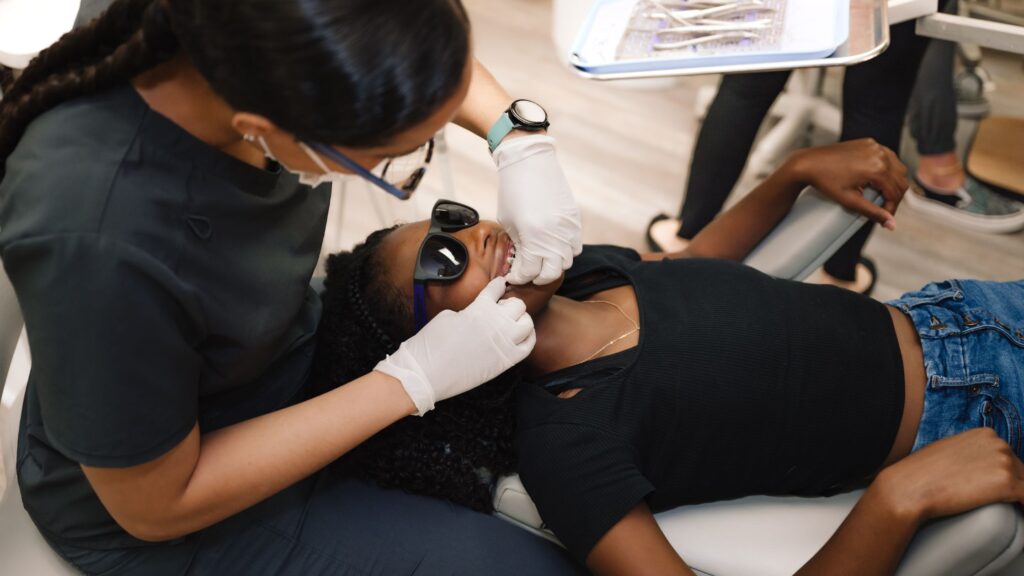Those who have never worn dental braces in the past but may soon need them often have a handful of pertinent questions to ask their orthodontist. You may want to know what it’s like to live with braces, how they are put on, how long you may need to wear them, and what kind of difference they will make for your smile.
These are certainly common questions and concerns. And as a help to those considering getting braces soon, we list 10 of the top questions new patients have about braces along with some helpful answers.
1. How Do I Know If I Need Braces?
You may suspect that you or a loved one will need dental braces to correct apparent tooth misalignment and bite problems. You may be having trouble chewing, speaking, or just aligning your upper and lower teeth when you close your mouth.
However, only a well-trained orthodontist can tell you for sure if you need braces or not. An orthodontist can do an examination of your teeth, mouth, and jaw to determine if braces are right for you. This will involve X-rays, a visual exam, probing of your oral cavity, and attention to the way your teeth align (or don’t.)
If you do need braces, your orthodontist will begin by creating a plan for improving your bite and the appearance of your smile.
2. What Type of Braces Should I Choose?
There are many types of braces available today, and it’s not always easy to know which type of braces will be right for you. The two main options these days are traditional metal braces and Invisalign® clear aligners, which are not really braces at all in the usual sense.
Traditional braces involve brackets that are fastened to each tooth, which are then connected by wires and “rubber bands.” Over time, metal braces guide your teeth into the proper position, but they need to be readjusted by your orthodontist periodically.
Invisalign® works differently. You wear a series of clear acrylic aligners. Each aligner is worn for two weeks, and the next aligner picks up where the last one left off in regard to realigning teeth. Many prefer Invisalign® because they are easier to use, can be removed for eating and cleaning, and because they are “invisible.”
3. How Long Does It Take to Apply Metal Braces?
Normally, it only takes a couple of hours at most to put metal braces in. The dental worker will begin by cleaning and drying your teeth. Then he or she will attach the brackets using dental “glue” (it is fully non-toxic and safe!) The archwires are then attached to bind the brackets together, and the correct amount of tension is applied.
The process is painless and relatively short. Some types of braces may take a little longer to “install” than others, but none of them take all that long.
4. How Often Will I Need to Have My Braces Adjusted?
Typically, you need to see your orthodontist every two or three weeks for a checkup and to have your braces re-adjusted. It’s important that the progress your teeth are making is carefully tracked and monitored to ensure all is going as planned.
Note that teeth will feel “tight” for a few days right after an adjustment, but that the tightness will fade over time. This is normal. It indicates that the braces are working!
5. What Will My Smile Look Like With Braces?
It’s obviously true that wearing braces will affect your smile, but remember that they will improve your smile once they have accomplished their mission!
There are metal-ceramic and colored braces that can make them look a little more pleasing in the meantime, and some opt for clear aligners that make it look like you are not wearing any braces at all. It’s probably best not to choose braces based on aesthetics alone, but that certainly is a factor to be considered.
6. Are Braces Uncomfortable to Wear?
Most people looking at the prospect of wearing braces are concerned about the “comfort level” or braces – and that is only to be expected. Anytime you are wearing something on your teeth, it’s not going to be as comfortable as not doing so – that goes without saying.
Invisalign® aligners are considered more comfortable to wear by most patients who’ve used them, but metal braces are more comfortable than they were 10 or 20 years ago – modern dentistry has come a long way!
Plus, realize that mild discomfort may occur when you first begin to wear your braces but that this will soon dissipate as your teeth, body, and mind get used to it. You will learn how to avoid touching the brackets the wrong way with your cheeks or tongue, and eventually, you will barely notice you are wearing braces because you are so accustomed to doing so.
7. What Kinds of Food Can I Eat With Braces?
Everyone loves to eat their favorite foods, and it’s only natural to ask how wearing braces will affect your diet. Immediately after having the braces put in, you should stick to a soft diet, but only if you are well-adjusted, there are only certain foods you need to worry about avoiding.
Basically, avoid sticky or chewy foods like gum or taffy, hard or crunchy foods like potato chips or nuts, and high-sugar foods and beverages. To limit chewing, cut food up into smaller pieces on your plate. Drink plenty of water, and clean your braces after each meal.
8. What About Oral Hygiene?
Braces require some special dental care. It’s all too easy for food particles and plaque to get stuck behind brackets or in hard-to-reach spots between teeth. Your orthodontist will provide you with some special oral hygiene tools to clean your braces, and you will need to have them inspected during your regular checkups.
With clear aligners, you can just remove them while eating and then put them back on. And you can clean them before putting them back on.
9. How Long Will It Take?
There are many factors affecting how quickly your teeth will realign through the use of dental braces.
In general, you will notice improvement within a month or two, and it may take from one to three years for the process to be complete. With Invisalign®, 6 to 18 months is typical.
10. What Comes After Braces?
When it’s time to finally remove your braces, it can be an exciting moment. With clear aligners, that’s normally it – you’re done. With metal braces, you may need to wear a removable retainer for a while to help maintain the new position of your teeth.
Either way, you will notice a much-improved smile and that your teeth align properly and function better.
For answers to any questions you may still have about braces or aligners, contact your local experts at Beauchamp Orthodontics. We look forward to hearing from you and helping you improve your smile!



